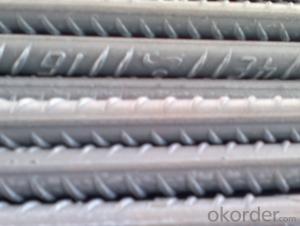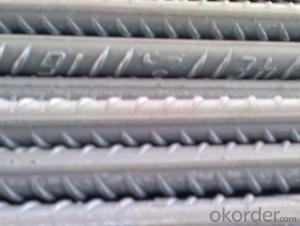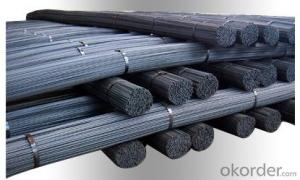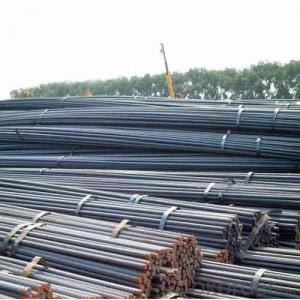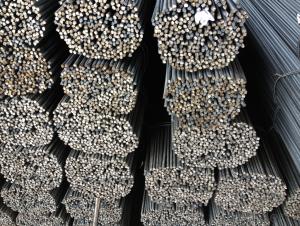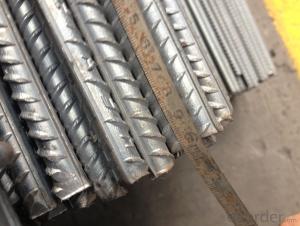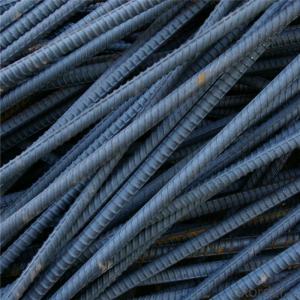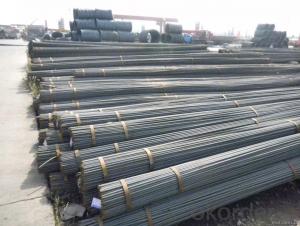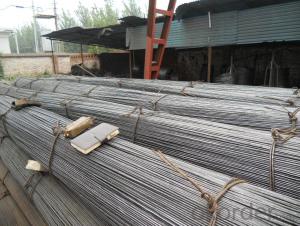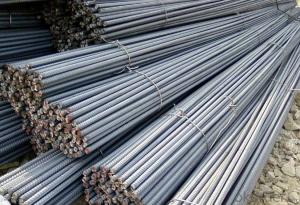ASTM Standard Deformed Steel Rebar GR40, GR60
- Loading Port:
- Tianjin
- Payment Terms:
- TT OR LC
- Min Order Qty:
- 25 m.t.
- Supply Capability:
- 200000 m.t./month
OKorder Service Pledge
OKorder Financial Service
You Might Also Like
Specification
Product Description:
OKorder is offering ASTM Standard Deformed Steel Rebar GR40, GR60 at great prices with worldwide shipping. Our supplier is a world-class manufacturer of steel, with our products utilized the world over. OKorder annually supplies products to European, North American and Asian markets. We provide quotations within 24 hours of receiving an inquiry and guarantee competitive prices.
Product Applications:
ASTM Standard Deformed Steel Rebar GR40, GR60 is widely used in buildings, bridges, roads and other engineering construction. Big to highways, railways, bridges, culverts, tunnels, public facilities such as flood control, dam, small to housing construction, beam, column, wall and the foundation of the plate, deformed bar is an integral structure material. With the development of world economy and the vigorous development of infrastructure construction, real estate, the demand for deformed bar will be larger and larger.
Product Advantages:
OKorder's ASTM Standard Deformed Steel Rebar GR40, GR60 are durable, strong, and resist corrosion.
Main Product Features:
· Premium quality
· Prompt delivery & seaworthy packing (30 days after receiving deposit)
· Corrosion resistance
· Can be recycled and reused
· Mill test certification
· Professional Service
· Competitive pricing
Specifications of Hot Rolled Deformed Steel Rebars for ASTM Standard Deformed Steel Rebar GR40, GR60
Standard | GB UK USA | HRB335 HRB400 HRB500 G460B, B500A, B500B,B500C GR40, GR60 | |
Diameter | 6mm,8mm,10mm,12mm,14mm,16mm,18mm,20mm, 22mm,25mm,28mm,32mm,36mm,40mm,50mm | ||
Length | 6M, 9M,12M or as required | ||
Payment term | TT or L/C | ||
Trade terms | FOB, CFR, CIF | ||
Application | Building, construction | ||
Each bundle weight | 2-3MT, or as required | ||
Type | Hot rolled steel rebar | ||
Brand name | OKORDER | ||
Theoretical weight and section area of each diameter as below for your information:
Diameter(mm) | Section area (mm²) | Mass(kg/m) | Weight of 12m (kg) | Pcs/ton |
6 | 28.27 | 0.222 | 2.664 | 375.38 |
8 | 50.27 | 0.395 | 4.74 | 210.97 |
10 | 78.54 | 0.617 | 7.404 | 135.06 |
12 | 113.1 | 0.888 | 10.656 | 93.84 |
14 | 153.9 | 1.21 | 14.52 | 68.87 |
16 | 201.1 | 1.58 | 18.96 | 52.74 |
18 | 254.5 | 2.00 | 24 | 41.67 |
20 | 314.2 | 2.47 | 29.64 | 33.74 |
22 | 380.1 | 2.98 | 35.76 | 27.96 |
25 | 490.9 | 3.85 | 46.2 | 21.65 |
28 | 615.8 | 4.83 | 57.96 | 17.25 |
32 | 804.2 | 6.31 | 75.72 | 13.21 |
36 | 1018 | 7.99 | 98.88 | 10.43 |
40 | 1257 | 9.87 | 118.44 | 8.44 |
50 | 1964 | 15.42 | 185.04 | 5.40 |
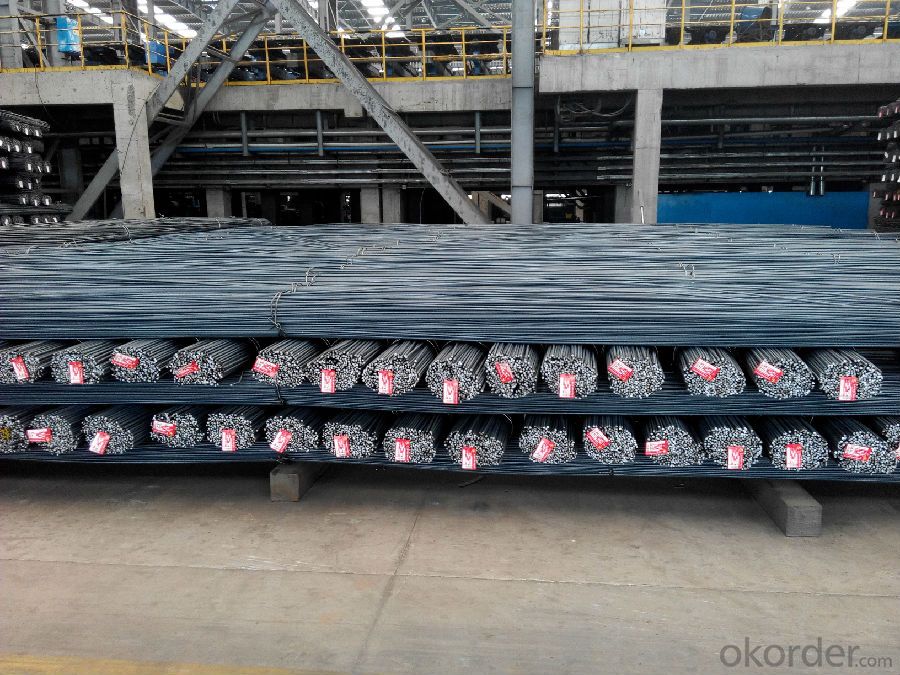
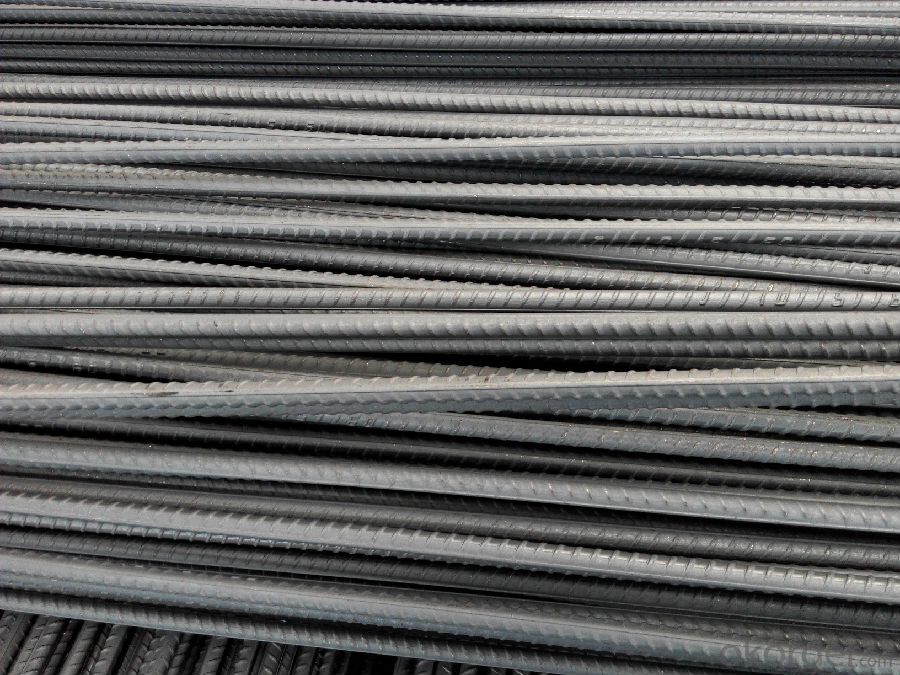
- Q: What are the guidelines for installing steel rebars in concrete columns?
- The guidelines for installing steel rebars in concrete columns involve several important considerations to ensure the structural integrity and durability of the columns. 1. Reinforcement design: The first step is to have a proper reinforcement design that specifies the size, length, and spacing of the rebars. This design should be prepared by a qualified engineer or consultant, taking into account the column's load-bearing requirements and the structural design standards. 2. Rebar preparation: Before installation, the steel rebars should be thoroughly cleaned to remove any rust, oil, or other contaminants that may hinder the bond between the rebar and the concrete. Additionally, the ends of the rebars should be properly cut and bent as specified in the reinforcement design. 3. Placement: The rebars should be placed accurately as per the reinforcement design. They should be positioned in the center of the column and secured to maintain the required spacing and alignment. The rebars should not touch the formwork or be placed too close to the edges of the column. 4. Splicing: When the height of the column exceeds the length of the rebar, splicing is necessary. Rebar splicing should be done according to the approved methods, such as lap splicing, mechanical couplers, or welded splices. The spliced rebars should have sufficient overlap length and provide a continuous load path. 5. Tying: Proper tying of the rebars is crucial to maintain their position during the concrete pouring. The rebars should be tied securely at the intersections using binding wire or other approved tying methods. The ties should be tight enough to prevent displacement but not too tight to damage the rebars. 6. Concrete pouring: Once the rebars are installed, the concrete is poured into the formwork, surrounding the rebars completely. Care should be taken to avoid segregation or honeycombing in the concrete, which can compromise the bond between the rebars and the concrete. 7. Concrete cover: The reinforcement design will specify the required concrete cover over the rebars. This cover protects the rebars from corrosion and provides fire resistance. It is crucial to maintain the specified concrete cover throughout the column's height and ensure it is not compromised during construction. 8. Quality control: Regular inspections and quality control measures should be implemented during the installation process. This includes checking the reinforcement alignment, spacing, and cover, as well as verifying the use of proper tying methods and splicing techniques. By following these guidelines, the installation of steel rebars in concrete columns can be carried out effectively, ensuring the structural strength and durability of the columns. It is essential to adhere to the local building codes and standards, as well as seek professional advice if needed, to ensure the proper installation of rebars in concrete columns.
- Q: How heavy can a 25 mm thread steel bear?
- Steel is known as hot rolled ribbed bar. Ordinary hot rolled steel bars are made up of HRB and the minimum yield point of the brand. H, R, and B are the first letters in English for hot-rolled (Hotrolled), ribbed (Ribbed) and reinforced (Bars) three words.
- Q: What are the factors that determine the strength of steel rebars?
- Several factors contribute to the strength of steel rebars. Firstly, the composition of the steel used in their manufacture plays a crucial role. The presence of elements like carbon, manganese, and silicon significantly impacts the steel's strength by enhancing its ability to resist tension and provide structural stability. Secondly, the manufacturing process of rebars influences their strength. Quenching and tempering, a process involving rapid cooling after heating, is typically employed to achieve the desired strength. The precise temperature and duration of this process affect the grain structure and chemical properties of the steel, thereby impacting the rebars' strength. The size and shape of rebars also affect their strength. The diameter and length of a rebar determine its load-bearing capacity. Thicker and longer rebars generally possess higher strength as they can withstand greater stress and distribute it more effectively. Furthermore, the presence of impurities or defects in the steel can weaken rebars. Cracks, voids, or inclusions compromise the structural integrity of the rebar and reduce its strength. Finally, environmental conditions must be considered when determining the strength of rebars. Factors like temperature, humidity, and exposure to corrosive substances can impact their strength over time. Taking precautions, such as using corrosion-resistant coatings or stainless steel rebars, is essential to ensure the longevity and strength of rebars in such environments. In conclusion, the strength of steel rebars depends on the composition of the steel, the manufacturing process, the size and shape of the rebars, the presence of defects, and the environmental conditions in which they will be used. Considering these factors is crucial to ensure the durability and reliability of steel rebars in construction applications.
- Q: How do steel rebars contribute to the energy efficiency of a building?
- There are several ways in which steel rebars contribute to the energy efficiency of a building. To begin with, they are used to reinforce concrete structures like beams, columns, and walls. This reinforcement enhances the building's structural integrity, enabling it to withstand different loads and forces. Consequently, the construction process requires fewer materials, resulting in a more energy-efficient building. Moreover, steel rebars possess exceptional thermal conductivity properties. This means they can effectively transfer and distribute heat throughout the building, aiding in regulating the internal temperature. By evenly dispersing heat, steel rebars help to minimize temperature fluctuations, thereby reducing the need for excessive heating or cooling systems and conserving energy. Furthermore, steel rebars have a lengthy lifespan and necessitate minimal upkeep. This durability ensures that the building remains structurally sound over time, decreasing the frequency of repairs or replacements. As a result, the energy consumed in maintenance and renovation activities is significantly reduced. Additionally, the use of steel rebars enables the construction of larger, open spaces with fewer supporting columns. This design flexibility allows for the incorporation of natural light and ventilation, reducing dependence on artificial lighting and air conditioning systems. By maximizing the utilization of natural resources, steel rebars contribute to the energy efficiency of the building. In conclusion, steel rebars play a crucial role in improving the energy efficiency of a building. Their ability to reinforce structures, efficient thermal conductivity, durability, and design flexibility all contribute to decreasing the energy consumption associated with the construction, maintenance, and operation of the building.
- Q: What is the purpose of stirrups in steel rebar reinforcement?
- Stirrups in steel rebar reinforcement serve to offer lateral support and improve the overall structural integrity of reinforced concrete components. Typically made of bent steel bars, stirrups are positioned around the longitudinal rebar within concrete columns, beams, or slabs. One of the primary functions of stirrups is to prevent buckling or bending of the longitudinal rebar caused by external forces like compression, tension, or shear. By enclosing the rebar with closely spaced stirrups, the strength and stability of the reinforced concrete element are significantly increased. Additionally, stirrups play a crucial role in resisting shear forces, which arise when a structure is subjected to lateral loads or earthquakes. These forces can lead to cracking and failure of the concrete. However, stirrups distribute shear stresses more evenly, effectively impeding the formation and propagation of cracks. Moreover, stirrups enhance the bond between the rebar and concrete by providing extra contact area. This, in turn, results in improved load transfer and prevents slippage between the rebar and the surrounding concrete. To summarize, stirrups in steel rebar reinforcement aim to enhance the structural strength, stability, and durability of reinforced concrete elements. They offer lateral support, resist bending and shear forces, and enhance the bond between the rebar and concrete. By incorporating stirrups into the reinforcement design, engineers can ensure that the concrete structure can withstand various external loads and maintain its integrity over time.
- Q: What are the common mistakes to avoid when handling and storing steel rebars?
- To ensure the quality and longevity of steel rebars, it is crucial to steer clear of certain common mistakes. Here are some errors that should be sidestepped: 1. Inadequate storage conditions: The storage of steel rebars in damp or wet areas can result in corrosion and rust. To prevent moisture accumulation, it is vital to store them in a dry and well-ventilated space. 2. Insufficient support: To prevent bending or deformation, it is important to provide proper support when stacking rebars. Insufficient support can damage the rebars and compromise their structural integrity. 3. Improper lifting techniques: It is essential to employ appropriate lifting equipment and techniques when handling rebars. Using hooks or chains directly on the rebars can weaken and damage them. It is advisable to use lifting devices specifically designed for rebar handling. 4. Overloading: Avoid placing excessive weight on storage racks or platforms. Overloading can cause structural failure and pose a risk to workers. Always adhere to the manufacturer's guidelines for maximum weight capacity. 5. Lack of protection: Rebars should be shielded from moisture, dirt, and other contaminants. Wrapping them properly with plastic or waterproof covers can prevent corrosion and maintain their quality. 6. Improper transportation: During transportation, take care to secure the rebars adequately to prevent movement or damage. Using appropriate restraints and padding can prevent potential accidents or rebar displacement. 7. Mixing different grades: Do not mix rebars of different grades together, as they possess varying strength and performance characteristics. Mixing different grades can compromise the overall structural integrity of the construction project. 8. Neglecting quality control: Conduct regular quality checks on the rebars to ensure they meet the required specifications. Neglecting quality control can result in the use of substandard rebars, jeopardizing the safety and durability of the structure. By avoiding these common mistakes, construction professionals can guarantee the proper handling and storage of steel rebars, leading to safer and more durable structures.
- Q: How do steel rebars prevent concrete structures from cracking under load?
- Steel rebars prevent concrete structures from cracking under load by providing reinforcement and increasing the tensile strength of the concrete. When the concrete is subjected to tensile forces, such as those caused by the weight or movement of the structure, it is prone to cracking. However, the inclusion of steel rebars within the concrete helps to distribute these tensile forces throughout the structure, making it more resistant to cracking. The steel rebars act as a framework, absorbing and dispersing the tension, thereby enhancing the overall structural integrity and preventing cracks from forming.
- Q: Can steel rebars be used in railway and transportation infrastructure?
- Yes, steel rebars can be used in railway and transportation infrastructure. Steel rebars, also known as reinforcing bars, are commonly used in the construction industry to provide strength and support to concrete structures. In railway and transportation infrastructure, where robust and durable structures are required, steel rebars are often used to reinforce concrete elements such as bridge piers, abutments, and retaining walls. The use of steel rebars in railway and transportation infrastructure offers several advantages. Firstly, steel rebars enhance the tensile strength of concrete, making the structures more resistant to the dynamic and heavy loads imposed by trains and vehicles. This is particularly important in bridges and elevated structures where the loads can be significant. Secondly, steel rebars provide structural integrity and prevent the development of cracks and deformations in the concrete. This is crucial for maintaining the long-term stability and safety of the infrastructure, especially considering the constant exposure to various environmental conditions, such as temperature variations and vibrations. Furthermore, steel rebars are highly durable and resistant to corrosion, which is essential in railway and transportation infrastructure that is often exposed to harsh weather conditions and chemical agents. Their ability to withstand these factors ensures the longevity of the structures and reduces the need for frequent repairs and maintenance. In conclusion, steel rebars can and are commonly used in railway and transportation infrastructure due to their ability to enhance the strength, durability, and stability of concrete structures. Their use ensures the safe and reliable operation of these vital transportation systems, providing a solid foundation for the efficient movement of people and goods.
- Q: How do steel rebars enhance the structural integrity of a building?
- In several ways, the structural integrity of a building is enhanced by steel rebars. Firstly, they reinforce and support concrete structures, including beams, columns, and slabs, preventing cracking or collapsing under heavy loads or external forces. The high tensile strength of steel rebars enables them to bear tensile stresses that concrete alone cannot handle, guaranteeing the building's stability and durability. Furthermore, steel rebars aid in evenly distributing and transferring loads throughout the structure, reducing concentrated stress. By reinforcing critical areas prone to tension, like corners, joints, and openings, rebars prevent cracks and ensure overall stability. Steel rebars also play a vital role in improving the structure's resistance to natural disasters like earthquakes and hurricanes. The flexibility and ductility of steel allow it to absorb and dissipate energy during seismic events or high winds, minimizing the risk of structural failure. This increased resilience ensures occupant safety and protects the building from severe damage. Additionally, steel rebars offer long-term durability by shielding the structure against corrosion. Unlike other construction materials, steel is highly resistant to degradation caused by environmental factors like moisture, chemicals, and temperature fluctuations. Corrosion-resistant rebars or protective coatings can significantly extend the building's lifespan. In conclusion, steel rebars are crucial components for reinforcing concrete structures, strengthening their integrity, stability, and resilience. By providing additional support and resistance to various stresses and loads, they contribute to the overall structural integrity of a building, guaranteeing its safety, longevity, and ability to withstand adverse conditions.
- Q: Can steel rebars be used in structures with aggressive chemical exposure?
- When working with structures that are exposed to aggressive chemicals, it is crucial to take precautions to prevent the corrosion of steel rebars. Over time, the corrosion weakens the structure. To minimize this risk, it is possible to apply corrosion-resistant coatings or materials to the rebars. These coatings create a barrier between the rebars and the aggressive chemicals, reducing the likelihood of corrosion by preventing direct contact. Moreover, it is necessary to regularly inspect and properly maintain the rebars to detect any signs of corrosion and take appropriate action. By implementing these protective measures, steel rebars can be safely utilized in structures exposed to aggressive chemicals.
Send your message to us
ASTM Standard Deformed Steel Rebar GR40, GR60
- Loading Port:
- Tianjin
- Payment Terms:
- TT OR LC
- Min Order Qty:
- 25 m.t.
- Supply Capability:
- 200000 m.t./month
OKorder Service Pledge
OKorder Financial Service
Similar products
Hot products
Hot Searches
Related keywords











